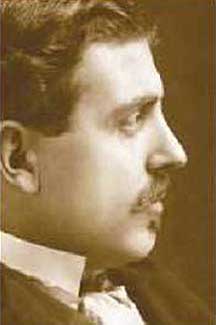The full title of this delightful vintage silent film is Cartoons on Tour: One of the Animated Grouch Chasers: A Cartoon Comedy by Raoul Barre (1915).
It is typical of Roaul Barre's cartoons from 1915, several of which were made up of four short-short cartoons shown between live-action sequences. These were made at Raoul's own cartoon studio, founded in 1914 & the first in America. Cartoons he made in 1914 & 1915 were distributed by the Edison Company in 1915 & 1916. He was afterward better known for the Mutt & Jeff cartoons.
In the live-action beginning of Cartoons on Tour, Lucille gets a telegram from Bob telling her he's on the way with marriage license & ring in hand. She then sits down on the porch to wait, & read a comic book by Tom E. Powers called The Grouch Chaser: The Tales of Silas Bunkas, the drawings for which become an animated cartoon.
Silas, a tubby bearded gent, tells his two friends, a farmer & a cop, about the time he was marooned on a desert island. There's a judicious use of word balloons as in actual funny pages, a great way to have dialogue in a silent film. When Silas encounters a weeping elephant, his word balloon quotes, "I guess a little snuff will fix em up all right."
He gives the sad elephant snuff & it begins sneezing so hard it blows Silas into the sky. He lands on a passing ship & is saved from being marooned. When the story's finished, the cop pushes Silas over, & Silas remarks in his word-balloon, "Folks don't beleive nuthin' no more!" with "beleive" mispelled on purpose I suppose.
Lucile on the porch bursts out laughing. She stands to see if her beau is coming yet, & seeing no one down the road, she goes into the garden to pick a bouquet. When Bob arrives, he's crabbing about his automobile troubles. But the problem is soon fixed, & off they go.
Lucille's dad begs them for a ride into town & climbs in back. He has no idea they're eloping. The film then cuts immediately to the next animated cartoon.
This one's called The Kelly Kids' Kite, featuring the very young Kelly lads encountered in other Raoul Barre cartoons. A grandfather is overseeing two tikes playing with a kite. The littlest one begs, "Let me hold it." Older brother shakes his head. Baby brother stomps his feet & starts crying in anger, so his brother lets him hold the string, & off the wee fellow goes into the air.
The Kelly tot is smiling & having a wonderful time until a crow lands on his head. "Cheese it!" says the kid. "Cheese it yourself," says the crow, & begins to peck the boy's head. So the kid grabs the crow & wrings its neck & the headless crow falls to earth. A black kid playing with two white kids says, "Here comes ma dinner!" He catches the headless crow & starts home with it.
Unable to hold on any longer, the Kelly kid drops to earth, but his baby dress forms a an open umbrella around his waist & he makes a soft landing & a pile of straw where a farmer was napping.
That's when Lucile & Bob reach their destination, but we only see the live-action bit for about three seconds before we leap into the third cartoon Mr. Hicks in Nightmareland.
Mr. Hercules Hicks is a little bald guy with a gi-normous wife, a recurring figure in Raoul Barre cartoons. He's got his telescope to his eye & he's watching a beautiful maiden out in shallows of the sea. When his wife figures out what he's up to, she picks up by the seat of his britches, holds him in the air with two fingers, & tweeks his nose.
He then falls asleep in his wife's huge lap comfortable as a baby, & goes into a dream. He finds the fountain of youth, swims in it, & comes out a weird looking little baby. A frog goes "Honk!" & scares baby Mr. Hicks, who runs off & meets another baby.
He takes the other infant's babybottle, but gets beaten up by the even smaller kid. Just as he finds himself in the lap of a beautiful maiden, he wakes up grumpy because his huge wife's smooching him.
It's now time for a quick pay-off for the live action bit. Lucile & Bob have gone inside the house of the Justice of the Peace while unknowing Dad reads the comic book in the back of the car. Between the pages he find's Bob's telegram & now realizes why they're at the Justice of the Peace.
Horrified he rushes to intervene, but it's too late, they're now married. Dad's angry until Lucille shows him the last comic strip in the book, The Pleasure of Being a Grandpa, a few seconds of an old guy dandling an infant on his knees.
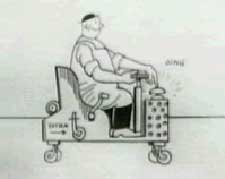 According to A Phable of a Busted Romance (1916), honesty doesn't pay. With simple but appealing line-drawing animation, a street vendor sees a wealthy lady drop her pocketbook. He returned it to her with a deep bow & a flourish. According to A Phable of a Busted Romance (1916), honesty doesn't pay. With simple but appealing line-drawing animation, a street vendor sees a wealthy lady drop her pocketbook. He returned it to her with a deep bow & a flourish.
The pocketbook happened to have had $10,000 in it, so Dennis fantasizes the maiden takes the vendor home so her dad can meet an honest man. Her father is so impressed that he sends Dennis to a good college. He graduates & gets a great job. Each expectation is pleasantly illustrated, & our street vendor is so hopeful.
Instead, the thankful maiden gave him one Canadian dime, with which Dennis bought himself an automobile. Which promptly blew up.
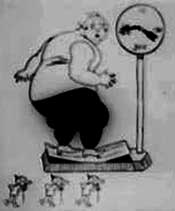 A fat lady commits herself to losing weight in The Phable of the Phat Woman (1916). We see her doing sundry exercises with what appear to be weird little fairies.
A fat lady commits herself to losing weight in The Phable of the Phat Woman (1916). We see her doing sundry exercises with what appear to be weird little fairies.
These tiny creatures practically live in a separate cartoon doing their stuff that reflects the dieting lady.
They always appearing at the bottom of the screen while the Phat Woman jogs or exercises or sits in a steambox or has an unsatisfying diet meal served by a stringbean of a maid.
In the end, of course, the Phat Woman weighs a whole lto more than when she started out on her plan to lose weight.
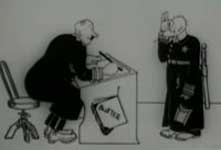 Never Again! The Story of a Speeder Cop (1916) shows what became of Officer Heeler who was committed to stopping speeders.
Never Again! The Story of a Speeder Cop (1916) shows what became of Officer Heeler who was committed to stopping speeders.
He's a geezerly traffic cop who stands in the midsst of traffic attempting to keep everything moving smoothly & at a safe speed. But cars never slow down. So he sets up a barrier, & it gets run down. As in Phable of the Phat Woman, there are elfin little critters that misbehave at the periphery of the frame.
Heeler sets up a huge barrier of boxes packed with sand & stands atop it yelling, "Stop!" as a vehicle plows through & nearly kills him. Totally unrelated, in the sky, a pilot-fairy in a tiny airplane shoots down another fairy riding in a small hot air balloon.
When Healer returns to the police station, he's ragged & injured, & promptly resigns from being a cop.
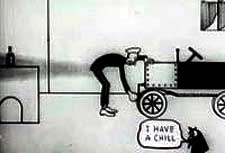 The "Phable" series was written & co-directed by comics illustrator Tom E. Powers, author also of Mr. Nobody Holme Buys a Jitney; or Mr . Nobody Holme: He Buys a Jitney (1916).
The "Phable" series was written & co-directed by comics illustrator Tom E. Powers, author also of Mr. Nobody Holme Buys a Jitney; or Mr . Nobody Holme: He Buys a Jitney (1916).
Based on Powers' Hearst-distributed comic strip "Mr. Nobody Holme," it's animated pretty much in the same style as the Barre cartoons, but the animator this time is Leon Searl, best known for Ignatz & Krazy Kat.
Skinny Mr. Holme is shown struggling to get his hand-crank auto started. He's a bit of a moron & uses a lit flame to look underneath the car.
The pinhead fairy folk make snide comments on the side (in word balloons), the fairy Gloom wanting Holme to blow himself up while holding a flame near the gas tank, & the fairy Joy wanting his car to work well.
Eventually the car gets going so that both Joy & Mr. Nobody Holme are just so glad. The primitive animation is ultra-watchable & charming.
copyright © by Paghat the Ratgirl
|
